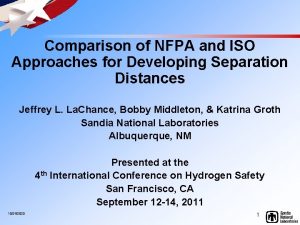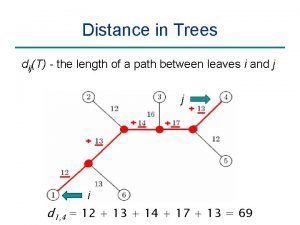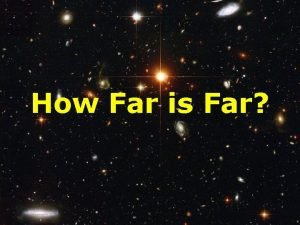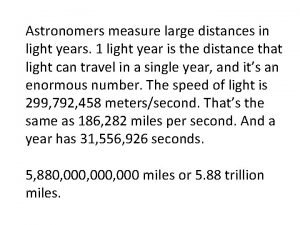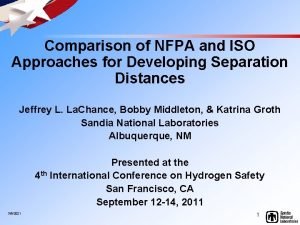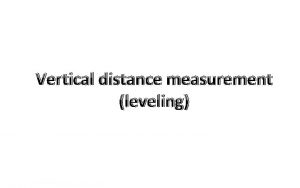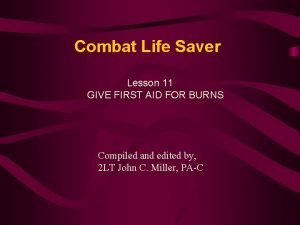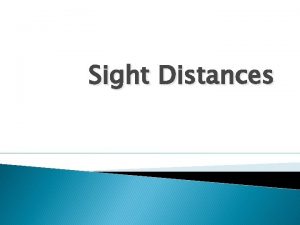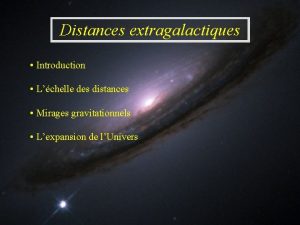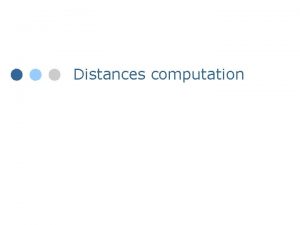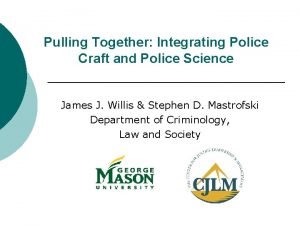Distances Pulling it Together 1 What are ways






















- Slides: 22

Distances: Pulling it Together 1. What are ways that we know distance? 2. How are the measures related? 3. What is the difference between a direct and an indirect measure? 4. What is a standard candle? What are some examples? 5. For what distance scale does each measurement work best?

Distances Radar measurements are DIRCECT measurement. 2 3 P =a

Distances We use parallax to get distances to nearby stars.

The Shape of the Universe We need to measure distances! FE = L 4 p d 2

Distances: Standard Candles Objects of known luminosity Main Sequence Stars Cepheid Variables Novae Supernovae Spiral Galaxies

Spectroscopic Parallax Recall Lecture Tutorial p. 45

Cepheid Variables Cepheids have a luminosity-period relationship

The Distance Ladder Each ‘rung’ on the ladder depends on the previous rung

The Distance Ladder If the real speed of light was slightly faster than we think A) our distances derived from Cepheids would be too small. B) our distances derived from Cepheids would be too large. C) only our Earth-Venus distance would be affected. D) No distances would be affected.

How do we measure the distances to galaxies?

Cepheids Because the period of Cepheid variable stars tells us their luminosities, we can use them as standard candles.

Type I SN The apparent brightness of a white dwarf supernova tells us the distance to its galaxy (up to 10 billion lightyears).

How do we measure the distances to galaxies?

Standard Candle: Cepheid variable stars with longer periods have greater luminosities.

Tully-Fisher Relation Entire galaxies can also be used as standard candles because a galaxy’s luminosity is related to its rotation speed.

Standard Candle: Type I SN Whitedwarf supernovae can also be used as standard candles.

Redshifted Galaxy Spectral features of virtually all galaxies are redshifted

Galactic Red Shift Everything is moving away!

The Universe is Expanding The space between galaxies must be increasing

Hubble’s Law Galaxies are moving away from us V = H 0 D Farther = Faster Large distances are quoted in redshift

Q: How could you find the age of the universe from Hubble’s Law? velocity = distance time velocity = Ho D Ho = 1/time

Expanding Universe Are we at the center? Is the answer ever yes?
 Antigentest åre
Antigentest åre Pulling it all together
Pulling it all together Gods ways are not our ways
Gods ways are not our ways Opvoedbelasting
Opvoedbelasting Easterlies and westerlies
Easterlies and westerlies Distances
Distances How do waves form
How do waves form What is the distance covered per unit of time?
What is the distance covered per unit of time? Images of weather systems on television come from *
Images of weather systems on television come from * A simple pendulum of length 40 cm subtends 60
A simple pendulum of length 40 cm subtends 60 Gas particles are separated by relatively large distances
Gas particles are separated by relatively large distances Iso 11620
Iso 11620 Tree distances i
Tree distances i Agility clockwise time
Agility clockwise time Far distances
Far distances The furthest distance i've travelled
The furthest distance i've travelled Astronomers measure large distances
Astronomers measure large distances East south east wind direction
East south east wind direction Nfpa separation distances
Nfpa separation distances How to measure vertical distance
How to measure vertical distance Ted likes to run long distances
Ted likes to run long distances Lesson 11 wire-pulling techniques
Lesson 11 wire-pulling techniques Magnetism is invisible
Magnetism is invisible











